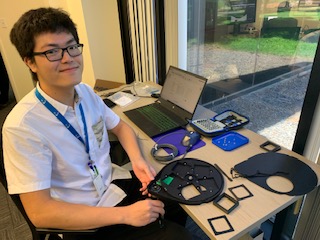
Ryan Wong was born in Honolulu and educated in Hong Kong before returning to Hawaii at the age of twelve. He graduated from President William McKinley High School in 2019 and is now attending the University of Hawaii at Manoa to pursue a Bachelor of Science degree in Mechanical Engineering. His career goal is to develop wearable mechanics, such as an exoskeleton, that will improve user movement. Ryan likes to spend his free time playing computer games, eating nice cuisine, building plastic models, and napping.
Home Island: Oahu
High School: President William McKinley High School
Institution when accepted: University of Hawaii at Manoa
Akamai Project: Mechanical Design, Assembly, and Testing of a Slitless Spectrograph for Satellite Characterization
Project Site: Odyssey Systems. Kihei HI
Mentor: Ryan Swindle
Project Abstract:
Odyssey Consulting, the U.S. Space Force Space Systems Command (SSC), and the Air Force Maui Optical & Supercomputing site (AMOS) are researching a precise methodology to characterize artificial satellites and other near-Earth objects using low-operation-cost telescopes while maintaining good coverage of the spectrum. Previous research on slitless spectroscopy has suggested its usefulness for detecting and distinguishing classes of satellites. Following this model, they have sought to fabricate various instrument parts for the first light (first operation) ground-based telescopes for spectral data collection using slitless spectroscopy. First, individual parts that required design or redesign were identified: zero-tilt adaptor, spacer and sprocket for FLI CFW 9-5 filter wheel, optics holders, and adaptor for filter wheel to telecompressor tube interface. Second, all parts were rendered in Autodesk Inventor and Fusion 360. Finally, an initial 3D-printout was created for test fitting, and the entire spectrograph was assembled using the definitive version. The main component, the optics holders, consists of the various combinations of transmission grating and wedge prisms, all enclosed in its 3D-printed shell. The custom holders were tightly fitted into the FLI CFW 9-5 filter wheel slot, allowing all incoming light to diffract and redirect back to the center of the telescope’s camera. Through successive iterations, various designs were adjusted and revised, due to the received product (filter wheel) varying from the CAD model obtained and the limited accuracy of the 3D printer. To preserve previous spatial dimensions, components required adjustment on-site, as the new installment will affect the overall telescope length. The final spectrograph will have its 3D-manufactured parts installed until more modifications or repurposing are needed.